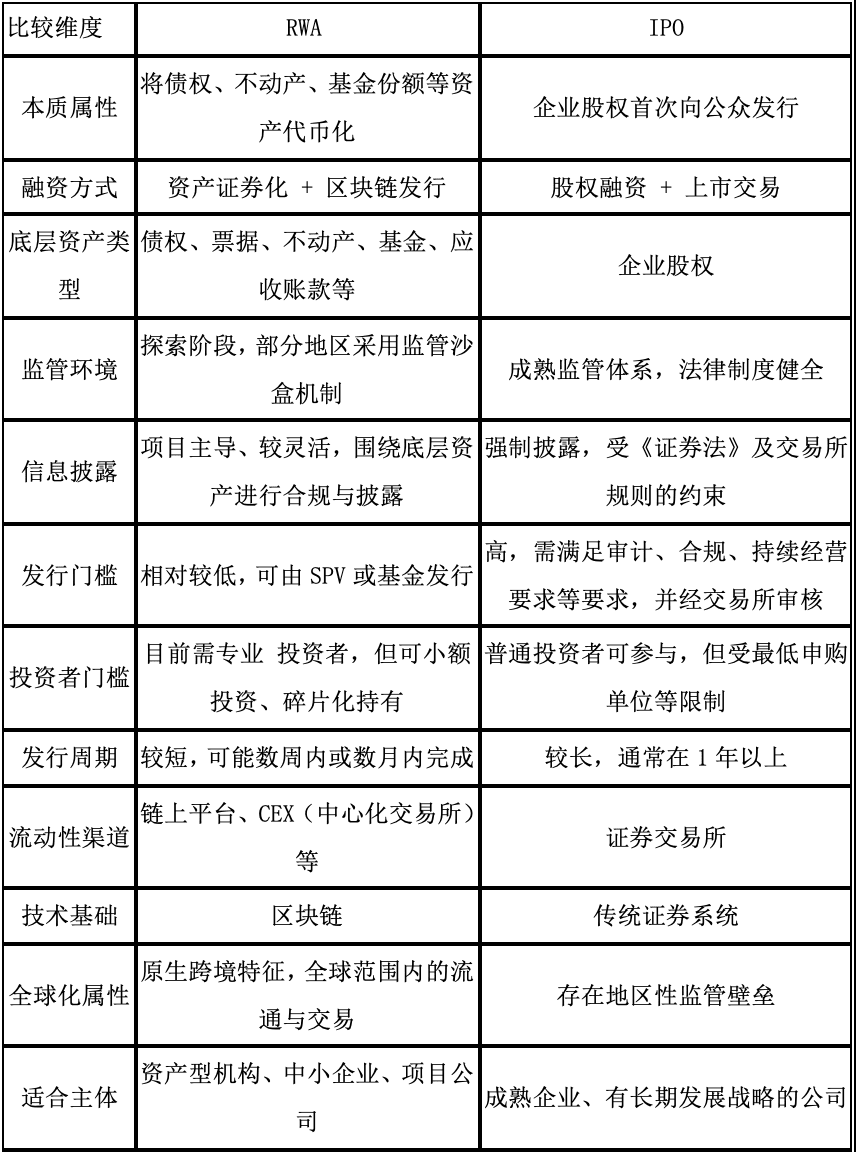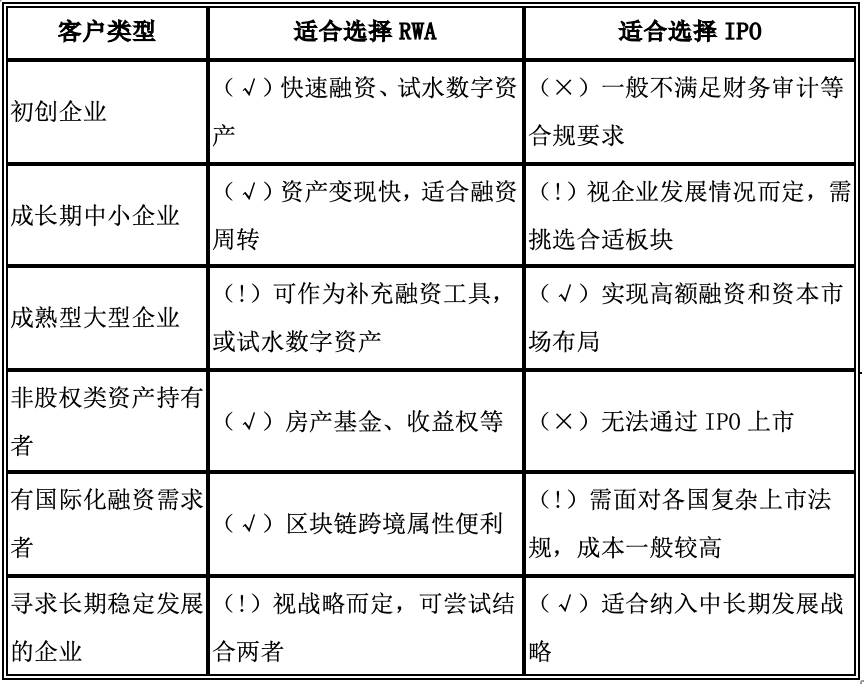Written by: Xiao Sa Legal Team
In recent years, with the development of blockchain technology and the continuous improvement of regulatory frameworks, the tokenization of RWA (Real World Assets) has gradually become the focus of attention in financial markets, with Hong Kong, the United States, Singapore, and other regions responding and experimenting to varying degrees. Meanwhile, traditional IPOs (Initial Public Offerings) remain an important way for companies to raise funds. So, what are the similarities and differences between RWA and IPO? What are their respective advantages? How should companies choose? Today, the team will discuss the relationship between the two to provide reference for enterprises with different needs when choosing financing paths.
01 Briefly discuss what RWA and IPO are
RWA, or the tokenization of Real World Assets, refers to the transformation of traditional financial assets such as debts, real estate, accounts receivable, fund shares, and bills into digital assets that can circulate on the blockchain using blockchain technology. This process can not only enhance the liquidity of assets but also reduce transaction costs and increase transparency. For example, a fund company can package its rights to income from real estate projects and issue them as virtual currencies on the blockchain, allowing global investors to participate in trading with lower thresholds.
IPO, or Initial Public Offering, is the act of a company issuing stocks to the public for the first time and listing on a stock exchange. It is the most formal, longest-standing, and most maturely regulated financing method in capital markets, requiring participation from accounting firms, law firms, and brokerage firms as intermediaries, undergoing strict financial audits, legal compliance reviews, and the preparation of prospectuses, marking the company's entry into the public market.
02 A table clarifying the main differences between RWA and IPO


03 The respective advantages of IPO and RWA
RWA and IPO share certain similarities to some extent, but due to the different financing logics, they each have their own advantages.
As an emerging financing method leveraging blockchain technology, RWA has the following advantages: (1) Low threshold and high efficiency: RWA can split investment amounts as needed, allowing participation with just hundreds or even tens of dollars, making it suitable for a broader range of investors. (2) Enhanced liquidity: Assets that are typically difficult to circulate, such as accounts receivable or real estate income rights, can be traded globally on the blockchain. (3) High issuance efficiency: It does not rely on traditional broker processes, eliminating lengthy waiting periods, and can be issued quickly once the technology is established. (4) On-chain transparency: All transaction records are traceable on-chain, enhancing trust mechanisms.
As a traditional method for companies to enter the capital market, IPO has the following advantages: (1) High financing amounts: Once successfully listed, a company can typically achieve financing amounts of hundreds of millions or even billions. (2) Enhanced brand reputation: Going public means passing strict regulatory reviews, significantly benefiting the company's brand image. (3) Greater capital operation space: Through subsequent issuances, mergers and acquisitions, equity incentives, and other tools, capital markets can multidimensionally empower the company's profit growth. (4) Well-established investor protection mechanisms: A relatively regulated environment, mature systems, and legal protections safeguard investors' rights. (5) A broad base of investor groups: Covering institutions, retail investors, and various types of investors, providing ample market liquidity.
04 Regulatory preference differences between IPO and RWA - A case study of Hong Kong
As an international financial center where East meets West, Hong Kong has always sought to balance traditional finance and emerging finance. In regulating RWA and IPO financing methods, Hong Kong exhibits a clear 'differentiated regulatory approach': emphasizing rigorous compliance, information disclosure, and investor protection for IPOs, while taking a relatively open, innovation-encouraging yet gradually regulatory approach for RWAs.
The Hong Kong IPO system has long followed a strict framework of the Securities and Futures Ordinance, with the listing process jointly regulated by the Hong Kong Stock Exchange and the Securities and Futures Commission (SFC), covering multiple stages such as sponsorship, due diligence, audit review, information disclosure, and public shareholding ratio. This ensures that listed companies have stable financial performance, sustainable operational capacity, and good governance structure. Such strong regulation not only protects investors' rights but also enhances the credibility of the Hong Kong market.
In contrast, Hong Kong's regulation of RWA demonstrates an 'inclusive and prudent' experimental mindset. The SFC has frequently issued regulatory circulars on tokenized assets in recent years, gradually establishing regulatory sandboxes and licensing systems for virtual asset service providers, and including RWA tokens in the category of eligible investment products for regulatory experimentation. For example, the circular issued in 2023 (regarding tokenized products recognized by the SFC) explicitly states that product providers must be responsible for the management and operational reliability of tokenization arrangements, ensuring compatibility with service providers, and must explain the reliability of related arrangements as required by the SFC, obtaining third-party verification and legal opinions when necessary, indicating Hong Kong's efforts to achieve a balance between financial advancement and investor protection.
05 A table clarifying the suitable client groups for IPO and RWA

06 In conclusion: IPO and RWA - Complementary rather than substitutive
We should recognize that RWA is not a substitute for IPO but rather a complement and reshaping of the traditional financing system. It provides unprecedented financing channels for small and medium-sized enterprises and asset holders, enhancing financial inclusivity; while IPOs remain a key pathway for companies to mature and embrace public markets and global capital. For enterprises, it is essential to choose or combine RWA and IPO rationally based on their development stage, financing needs, asset structure, and strategic layout. In the future, with the maturity of regulatory mechanisms, reduction of technical barriers, and enhancement of market acceptance, RWA and IPO are expected to jointly construct a more diverse, transparent, and efficient financing ecosystem.


